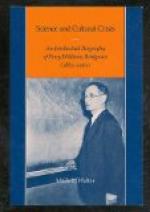|
This section contains 365 words (approx. 2 pages at 300 words per page) |
(1882-1961) American physicist Percy Williams Bridgman was born in Cambridge, Massachusetts, on April 21, 1882. He attended public schools in Newton, Massachusetts, and then entered Harvard University in 1900. He earned his bachelors, masters, and finally, his doctorate (1908) at Harvard. Upon graduation, Bridgman was appointed to the faculty at Harvard, where he remained for the rest of his life. Even after his retirement in 1954, he continued doing research at the University's Jefferson Physical Laboratory. Bridgman devoted his academic career to a single topic, high pressure physics. In the 1880s French physicists Louis Paul Cailletet (1832-1913) and Emile Hilaire Amagat (1841-1915) invented devices for studying the effects of pressures as high as 3,000 atmospheres (44,000 pounds per square inch) on materials. At pressures greater than 3,000 atmospheres, however, the seals on their devices failed. It seemed that a limit on high pressure research had been reached. In 1905, Bridgman decided to study the effects of high pressure on certain optical phenomena. When an explosion damaged the equipment he was using, he turned his attention to the machine used to produce high pressure, rather than the optical phenomena. He set about to develop a high pressure device in which the seal would not fail and which, therefore, could produce pressures greater than those achieved by Cailletet and Amagat. The approach he developed involved a seal that became tighter with increased pressures. The external support on the device was also constructed so that it became stronger as the pressure increased. Bridgman's device was so successful that he was soon able to produce pressures of 20,000 atmospheres (300,000 pounds per square inch). Further developments over the years made possible devices that could produce pressures of 100,000 atmospheres (1,500,000 pounds per square inch). With these devices, Bridgman and other scientists were able to explore a great variety of high pressure phenomena. He discovered a new form of ice, for example, that has a melting point of 200° C at 40,000 atmospheres of pressure. His devices have also been used by geologists to study the behavior of matter at pressures similar to those at the earth's core. In 1955, a team of General Electric researchers, with Bridgman as consultant, used a high pressure device to create the first synthetic diamonds.
|
This section contains 365 words (approx. 2 pages at 300 words per page) |


